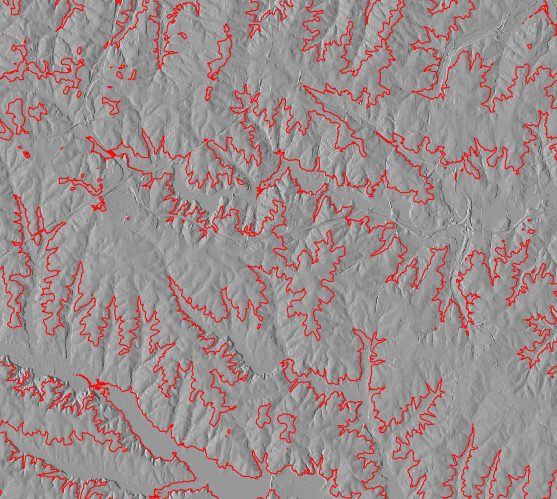r.contour
Produces a vector map of specified contours from a raster map.
r.contour [-t] input=name output=name [step=float] [levels=float [,float,...]] [minlevel=float] [maxlevel=float] [cut=integer] [--overwrite] [--verbose] [--quiet] [--qq] [--ui]
Example:
r.contour input=name output=name
grass.script.run_command("r.contour", input, output, step=None, levels=None, minlevel=None, maxlevel=None, cut=2, flags=None, overwrite=None, verbose=None, quiet=None, superquiet=None)
Example:
gs.run_command("r.contour", input="name", output="name")
grass.tools.Tools.r_contour(input, output, step=None, levels=None, minlevel=None, maxlevel=None, cut=2, flags=None, overwrite=None, verbose=None, quiet=None, superquiet=None)
Example:
tools = Tools()
tools.r_contour(input="name", output="name")
This grass.tools API is experimental in version 8.5 and expected to be stable in version 8.6.
Parameters
input=name [required]
Name of input raster map
output=name [required]
Name for output vector map
step=float
Increment between contour levels
levels=float [,float,...]
List of contour levels
minlevel=float
Minimum contour level
maxlevel=float
Maximum contour level
cut=integer
Minimum number of points for a contour line (0 -> no limit)
Default: 2
-t
Do not create attribute table
--overwrite
Allow output files to overwrite existing files
--help
Print usage summary
--verbose
Verbose module output
--quiet
Quiet module output
--qq
Very quiet module output
--ui
Force launching GUI dialog
input : str, required
Name of input raster map
Used as: input, raster, name
output : str, required
Name for output vector map
Used as: output, vector, name
step : float, optional
Increment between contour levels
levels : float | list[float] | str, optional
List of contour levels
minlevel : float, optional
Minimum contour level
maxlevel : float, optional
Maximum contour level
cut : int, optional
Minimum number of points for a contour line (0 -> no limit)
Default: 2
flags : str, optional
Allowed values: t
t
Do not create attribute table
overwrite : bool, optional
Allow output files to overwrite existing files
Default: None
verbose : bool, optional
Verbose module output
Default: None
quiet : bool, optional
Quiet module output
Default: None
superquiet : bool, optional
Very quiet module output
Default: None
input : str | np.ndarray, required
Name of input raster map
Used as: input, raster, name
output : str, required
Name for output vector map
Used as: output, vector, name
step : float, optional
Increment between contour levels
levels : float | list[float] | str, optional
List of contour levels
minlevel : float, optional
Minimum contour level
maxlevel : float, optional
Maximum contour level
cut : int, optional
Minimum number of points for a contour line (0 -> no limit)
Default: 2
flags : str, optional
Allowed values: t
t
Do not create attribute table
overwrite : bool, optional
Allow output files to overwrite existing files
Default: None
verbose : bool, optional
Verbose module output
Default: None
quiet : bool, optional
Quiet module output
Default: None
superquiet : bool, optional
Very quiet module output
Default: None
Returns:
result : grass.tools.support.ToolResult | None
If the tool produces text as standard output, a ToolResult object will be returned. Otherwise, None will be returned.
Raises:
grass.tools.ToolError: When the tool ended with an error.
DESCRIPTION
r.contour produces a vector map of specified contours from input raster map. Contours can be produced using a comma-separated list of values in levels, or at some regular increment using the step parameter, using minlevel and maxlevel as minimum and maximum contour values, respectively. If no minlevel or maxlevel is specified, the minimum and maximum cell values in the input raster map will be used.
NOTES
r.contour will either step through incremental contours or produce contours from a list of levels, not both. If both a list of levels and a step are specified, the list will be produced and the step will be ignored.
Zero is treated as a valid data value by r.contour.
If a contour level exactly matches a category value in the raster map, the contour line may backtrack on itself, causing illegal arcs to be produced in the output vector map.
The optional cut parameter allows the user to specify a minimum number of raster cells eligilble to be included in a contour line written to the output vector map. It acts like a filter, omitting spurs, single points, etc., making the output more generalized.
EXAMPLES
In the Spearfish dataset, produce a vector contour map from input raster elevation.dem with contour levels from 1000m to 2000m, 100m contour step, and a minimum of 200 input raster points contributing to the contour line:
r.contour input=elevation.dem output=elevation_dem_contours \
minlevel=1000 maxlevel=2000 step=100 cut=200
For an example of using levels with r.contour this example uses the elevation map from the North Carolina database:
g.region raster=elevation
r.contour in=elevation out=contours levels=60,90,120,150 --o
d.mon wx0
d.rast elevation_shade
d.vect contours color=red

Contour lines shown on shaded terrain map
For an example of using steps with r.contour this example uses the LiDAR data derived elevation map from the North Carolina database:
g.region raster=elev_lid792_1m -p
r.contour input=elev_lid792_1m output=elev_lid792_1m_contours \
minlevel=100 maxlevel=150 step=10
AUTHORS
Terry Baker, U.S. Army Construction Engineering Research Laboratory
3/2001: cut parameter and fixes by Andrea Aime (aaime@libero.it)
SOURCE CODE
Available at: r.contour source code
(history)
Latest change: Monday Dec 22 18:07:47 2025 in commit cd86ea8